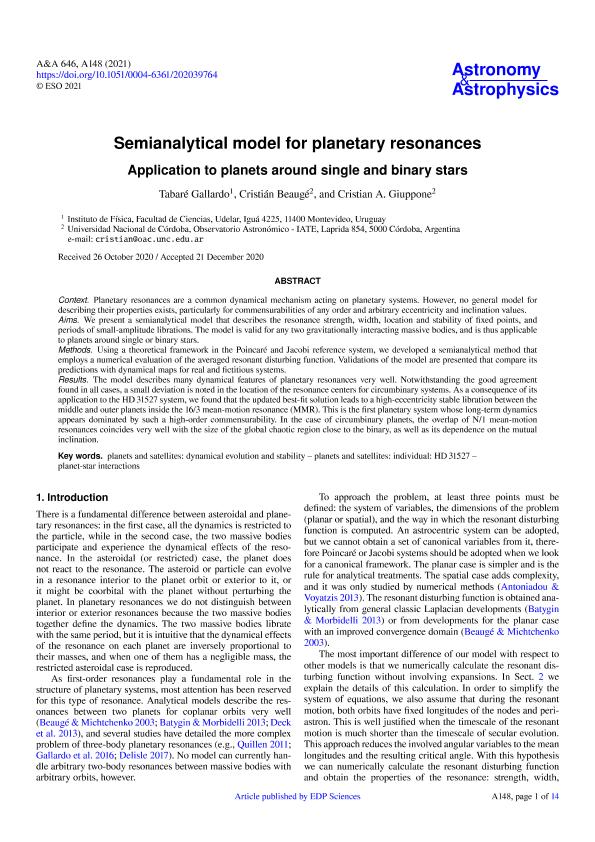Mostrar el registro sencillo del ítem
dc.contributor.author
Gallardo, Tabaré

dc.contributor.author
Beauge, Cristian

dc.contributor.author
Giuppone, Cristian Andrés

dc.date.available
2022-09-23T19:21:09Z
dc.date.issued
2021-02
dc.identifier.citation
Gallardo, Tabaré; Beauge, Cristian; Giuppone, Cristian Andrés; Semianalytical model for planetary resonances: Application to planets around single and binary stars; EDP Sciences; Astronomy and Astrophysics; 646; A148; 2-2021; 1-14
dc.identifier.issn
0004-6361
dc.identifier.uri
http://hdl.handle.net/11336/170294
dc.description.abstract
Context. Planetary resonances are a common dynamical mechanism acting on planetary systems. However, no general model for describing their properties exists, particularly for commensurabilities of any order and arbitrary eccentricity and inclination values. Aims. We present a semianalytical model that describes the resonance strength, width, location and stability of fixed points, and periods of small-amplitude librations. The model is valid for any two gravitationally interacting massive bodies, and is thus applicable to planets around single or binary stars. Methods. Using a theoretical framework in the Poincaré and Jacobi reference system, we developed a semianalytical method that employs a numerical evaluation of the averaged resonant disturbing function. Validations of the model are presented that compare its predictions with dynamical maps for real and fictitious systems. Results. The model describes many dynamical features of planetary resonances very well. Notwithstanding the good agreement found in all cases, a small deviation is noted in the location of the resonance centers for circumbinary systems. As a consequence of its application to the HD 31527 system, we found that the updated best-fit solution leads to a high-eccentricity stable libration between the middle and outer planets inside the 16/3 mean-motion resonance (MMR). This is the first planetary system whose long-term dynamics appears dominated by such a high-order commensurability. In the case of circumbinary planets, the overlap of N/1 mean-motion resonances coincides very well with the size of the global chaotic region close to the binary, as well as its dependence on the mutual inclination.
dc.format
application/pdf
dc.language.iso
eng
dc.publisher
EDP Sciences

dc.rights
info:eu-repo/semantics/openAccess
dc.rights.uri
https://creativecommons.org/licenses/by-nc-sa/2.5/ar/
dc.subject
PLANET-STAR INTERACTIONS
dc.subject
PLANETS AND SATELLITES: DYNAMICAL EVOLUTION AND STABILITY
dc.subject
PLANETS AND SATELLITES: INDIVIDUAL: HD 31527
dc.subject.classification
Astronomía

dc.subject.classification
Ciencias Físicas

dc.subject.classification
CIENCIAS NATURALES Y EXACTAS

dc.title
Semianalytical model for planetary resonances: Application to planets around single and binary stars
dc.type
info:eu-repo/semantics/article
dc.type
info:ar-repo/semantics/artículo
dc.type
info:eu-repo/semantics/publishedVersion
dc.date.updated
2022-09-21T13:53:50Z
dc.identifier.eissn
1432-0746
dc.journal.volume
646
dc.journal.number
A148
dc.journal.pagination
1-14
dc.journal.pais
Francia

dc.journal.ciudad
París
dc.description.fil
Fil: Gallardo, Tabaré. Universidad de la República; Uruguay
dc.description.fil
Fil: Beauge, Cristian. Observatorio Astronomico de la Universidad Nacional de Cordoba; Argentina. Consejo Nacional de Investigaciones Científicas y Técnicas. Centro Científico Tecnológico Conicet - Córdoba. Instituto de Astronomía Teórica y Experimental. Universidad Nacional de Córdoba. Observatorio Astronómico de Córdoba. Instituto de Astronomía Teórica y Experimental; Argentina
dc.description.fil
Fil: Giuppone, Cristian Andrés. Observatorio Astronomico de la Universidad Nacional de Cordoba; Argentina. Consejo Nacional de Investigaciones Científicas y Técnicas. Centro Científico Tecnológico Conicet - Córdoba. Instituto de Astronomía Teórica y Experimental. Universidad Nacional de Córdoba. Observatorio Astronómico de Córdoba. Instituto de Astronomía Teórica y Experimental; Argentina
dc.journal.title
Astronomy and Astrophysics

dc.relation.alternativeid
info:eu-repo/semantics/altIdentifier/doi/http://dx.doi.org/10.1051/0004-6361/202039764
dc.relation.alternativeid
info:eu-repo/semantics/altIdentifier/url/https://www.aanda.org/articles/aa/full_html/2021/02/aa39764-20/aa39764-20.html
Archivos asociados
